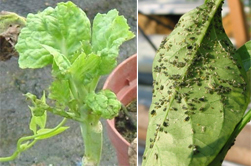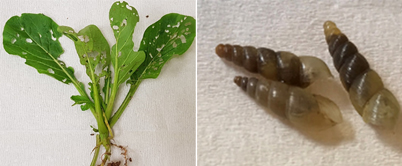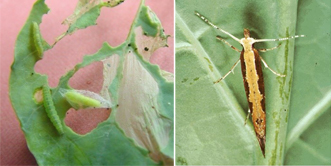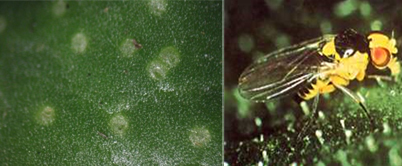Know Five Common Pests
Pests are organisms that cause damage or injury to plants. Generally, they can be insects, pathogens such as fungi, bacteria and viruses and plant parasitic nematodes. Here are five common insect pests of edible plants. Learn more about them and how you can keep your garden safe from their attack.
1. Aphids
Aphids are sap-sucking bugs that are small and pear-shaped. They may be green, yellow, brown-red or black. If left untended for a certain period of time, aphids may weaken an entire plant, causing stunted growth or even death. They also spread many viral plant diseases.
Vulnerable Plants
Leafy vegetables and fruiting vegetables such as beans, brinjal, chilli, lady’s finger and tomato.
Symptoms
Infested leaves and stems curl downwards, and developing fruits may become distorted. Leaves, stems and fruits appear sticky, and can become covered in sooty mould.
Preventive and Control Measures
Regularly check your plants for aphids on the underside of leaves and terminal shoots which may be distorted or curled. Avoid over-fertilising as this may encourage further aphid outbreak.
2. Awl Snails
Commonly known as Awl Snails, Allopeas snails have a yellow body and an elongated shell. Awl snails are usually found in large numbers. They are commonly found in wet, shaded areas of greenhouses, in leaf debris, under stones and in the soil beneath grasses.
Vulnerable Plants
Most leafy vegetables and fruiting vegetables such as zucchini.
Symptoms
Awl snails eat leaves, shoots and flowers, creating holes.
Preventive and Control Measures
Requires an integrated management approach, including the selection and planting of non-infected nursery stock, and manually removing the snails.
3. Diamondback Moths
The caterpillars of the Diamondback Moth are common and widespread in hot and dry weather. They are light brown to green. When disturbed, they wriggle rapidly and drop from the leaves on silk threads which they use to climb back.
Vulnerable Plants
Most leafy Brassicas, such as bai cai, caixin, kalian, watercress and xiao bai cai.
Symptoms
The affected leaves can become skeletonised by the caterpillars, which are voracious feeders in their last stage.
Preventive and Control Measures
Nets can be used to cover susceptible plants. Rotating crops with non-Brassica plants, such as bayam, kangkong or onions may help break the insect life cycle. Also, infested leaves may harbour larvae or eggs. Discard the waste and do not use it for compost to prevent re-introduction to new plants.
4. Leaf Miners
Leaf miner larvae feed on leaves, creating tunnelling mine trails. The most common leaf miners present in Singapore are Liriomyza sativae and L. trifolii.
Vulnerable Plants
Most leafy vegetables and fruiting vegetables, including beans, lady’s finger and sweet pea.
Symptoms
Infested leaves have translucent leaf mining trails.
Preventive and Control Measures
Infected leaves should be physically removed. Rotate crops with non-susceptible leafy vegetables, such as bayam or kailan. Yellow sticky traps can also be used to trap the adult flies.
5. Flea Beetles

Adult flea beetles are small, nocturnal insects that are voracious feeders of young leafy vegetables.
Vulnerable Plants
Mostly leafy vegetables from the genus Brassica.
Symptoms
Round holes can be found on infected leaves, and plants may display reduced growth.
Preventive and Control Measures
Remove infested plants from the garden. As the insects may have laid eggs in the soil, it is advisable to replace the top 10 to 15 cm of existing soil as well. ‘Trap crops’ such as mustard and radish can be planted as buffer plants to attract the flea beetles away from the main leafy vegetables. Rotating crops with leafy vegetables such as bayam and kangkong may help break the life cycle of flea beetles.
Keeping Plants Safe from Pests
Pests can affect the harvesting of your edible plants. But there are some simple but effective ways to keep your plants safe from pests.
(1) Keep Your Garden Clean
Remove pest sources to reduce their presence. For example, remove dead, diseased and insect infested plants and prune away dead and unhealthy branches. After pruning, disinfect your tools in a 5% bleach solution before using to a new host plant.
(2) Maintain Plant Health
Healthy plants are usually better able to resist pests. Promote good growth by watering your plants adequately and following a fertiliser regime. Ensure that there is enough ventilation and soil drainage, to reduce excessive moisture and avoid creating conditions that may favour diseases to develop.
(3) Grow Plant Varieties with Strong Resistance
Pick hardy plants and varieties for your garden, and plant a variety of plant types so that certain types of pests are less likely to spread across the garden.
(4) Adopt an Integrated Pest Management Programme
For long-term pest prevention, consider using a combination of controls, such as
- Encourage natural enemies of pests
Allow natural predators of garden pests to flourish by minimising the use of pesticides. Wasps, ants, spiders, lacewings, ladybird beetles and birds all help to control pest populations.
- Use mechanical forms of pest control
Create physical barriers to prevent pests from entering such as planting within a netted structure and wrapping fruits. To help remove pests such as whiteflies, aphids and thrips, use sticky traps and/or pheromone. Chemical lures may also be used to trap them.
(5) Use pesticides only when necessary
Use pesticides only when necessary to counter severe problems with pests. Identify the pest so that the appropriate chemical(s) can be used to effectively counter the problem.
Learning More
Looking to start gardening? Join our Community in Bloom programmes or form your own gardening interest group. If you want to involve the entire family, join us at our monthly Gardener’s Day Out and meet fellow gardening enthusiasts, participate in eco-friendly workshops and shop for new plants.
For more gardening resources including instructive videos and tips for caring for your plants, click here.
How can you make your garden more welcoming to bees? Learn more here.
For more information about the flora and fauna found in Singapore, please visit Flora and Fauna Web.
Text compiled by Felix Siew









Have views or comments on this article? Let us know via this form. If you would like to give us feedback on any other areas relating to our parks and gardens, please submit via https://www.nparks.gov.sg/feedback